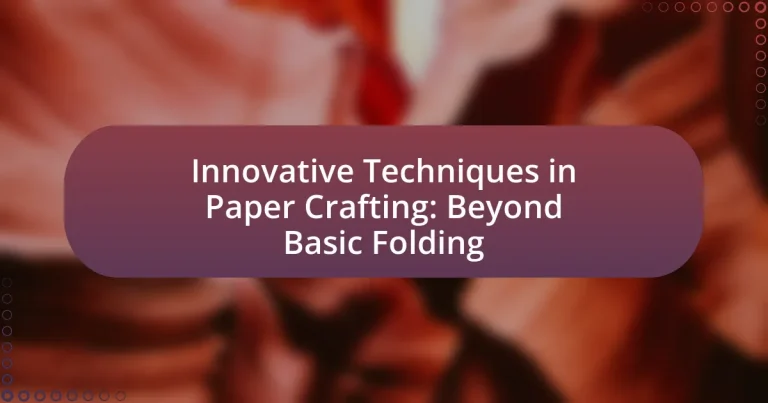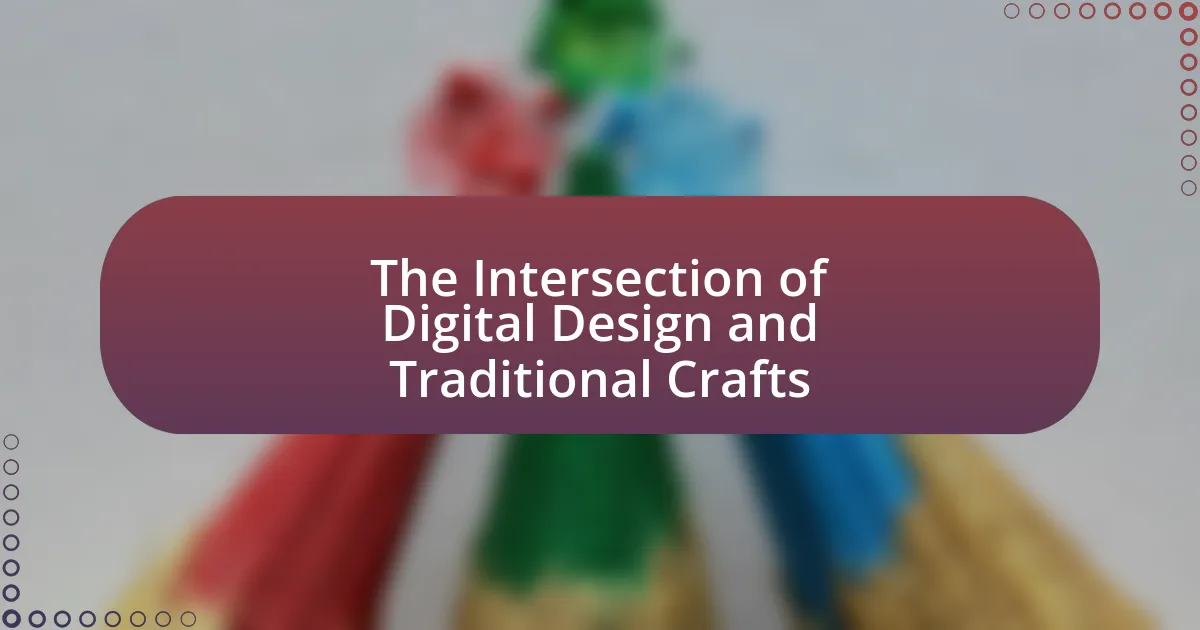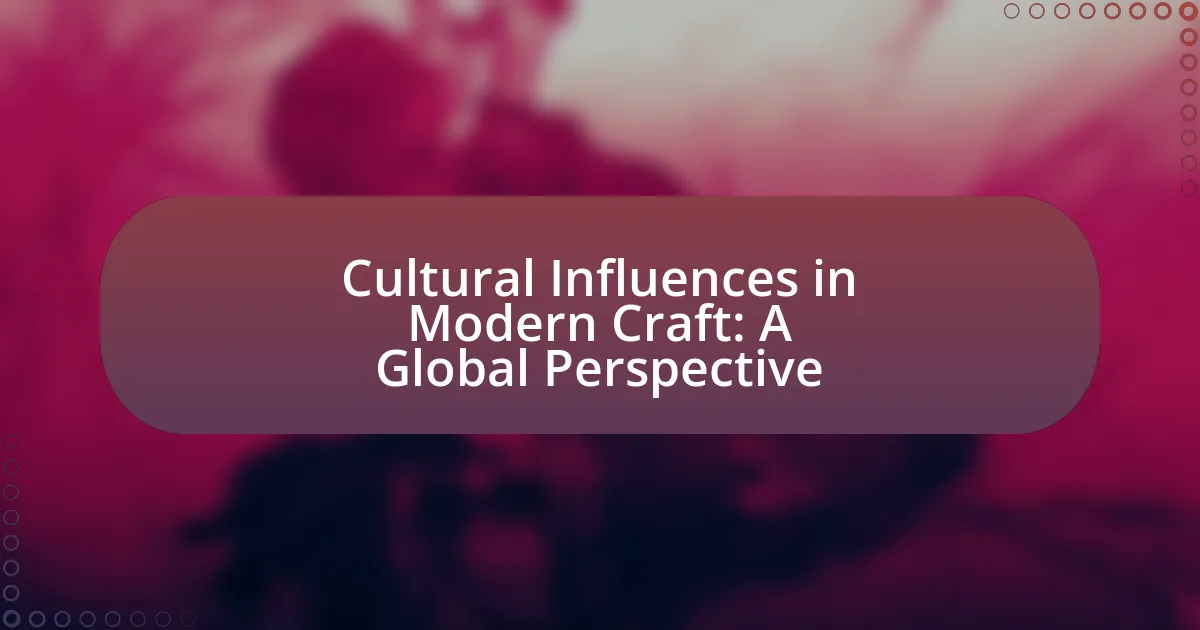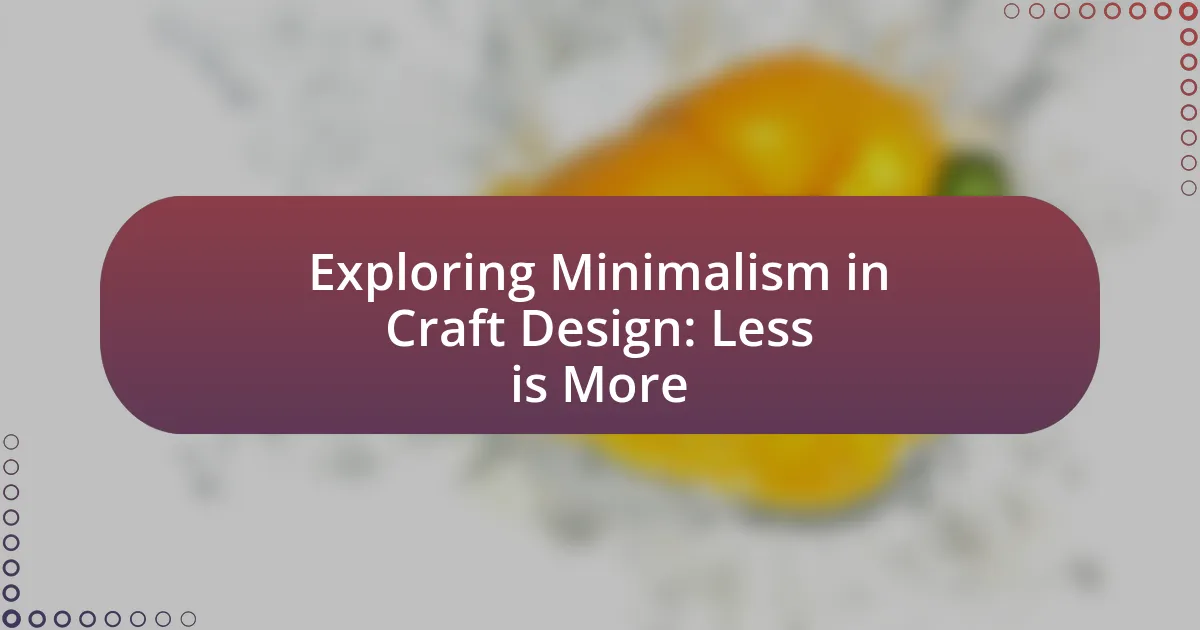Innovative techniques in paper crafting encompass advanced methods such as quilling, paper cutting, and 3D modeling, which enhance creativity and complexity beyond basic folding. These techniques utilize specialized materials and tools, including digital cutting machines, to create intricate designs and structures. The article explores the differences between basic folding and innovative techniques, highlighting their unique characteristics, benefits, and the impact on the final product’s aesthetics and durability. Additionally, it discusses the emotional and psychological advantages of engaging in paper crafting, as well as resources and tips for beginners to adopt these advanced methods effectively.
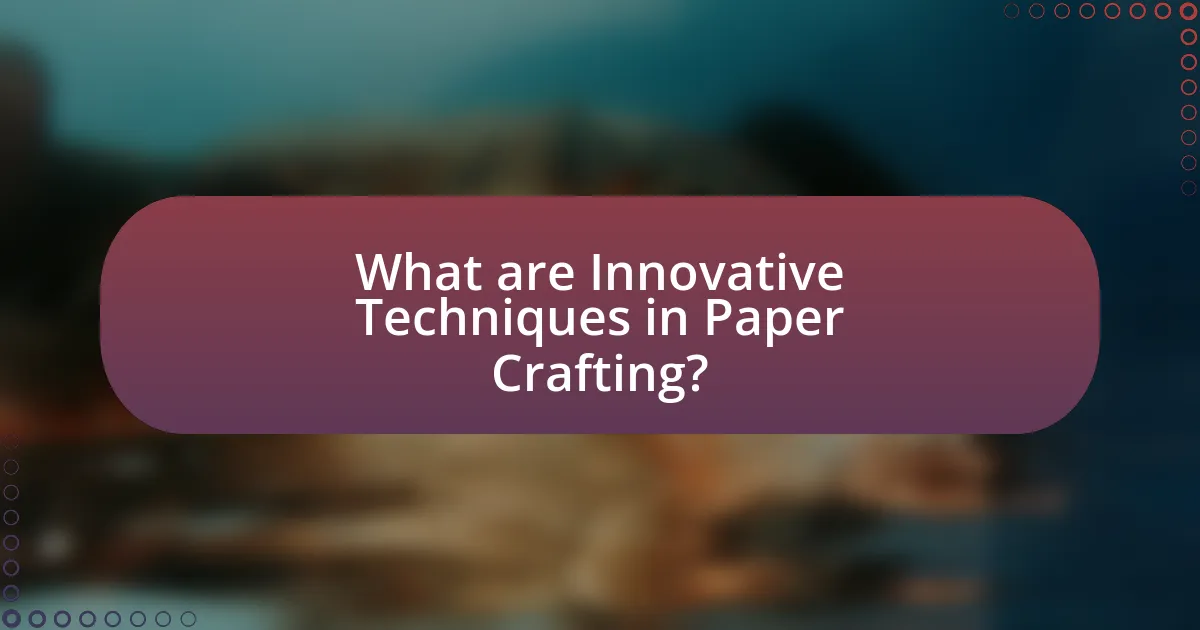
What are Innovative Techniques in Paper Crafting?
Innovative techniques in paper crafting include methods such as quilling, paper cutting, and 3D paper modeling. Quilling involves rolling and shaping strips of paper to create intricate designs, which has roots in 15th-century Europe and has evolved into a popular craft today. Paper cutting, often seen in traditional Chinese art, allows for detailed designs and patterns to be created by cutting paper with precision tools. 3D paper modeling, which includes techniques like origami and pop-up designs, transforms flat sheets into three-dimensional structures, enhancing the visual and tactile experience of paper crafts. These techniques push the boundaries of traditional paper crafting, allowing for greater creativity and complexity in projects.
How do these techniques differ from basic folding?
Innovative techniques in paper crafting differ from basic folding by incorporating advanced methods such as scoring, cutting, and layering to create more complex structures and designs. While basic folding primarily involves simple creases to shape paper, these advanced techniques allow for the manipulation of paper in ways that enhance dimensionality and detail, enabling the creation of intricate models and artistic expressions. For example, techniques like origami involve precise folds that transform a flat sheet into a three-dimensional figure, whereas basic folding would not achieve such complexity.
What are the key characteristics of innovative paper crafting techniques?
Innovative paper crafting techniques are characterized by their use of advanced materials, integration of technology, and unique design approaches. These techniques often incorporate non-traditional materials such as specialty papers, adhesives, and embellishments that enhance the aesthetic and functional aspects of the crafts. Additionally, the integration of technology, such as digital cutting machines and software, allows for precision and complexity in designs that were previously difficult to achieve. Unique design approaches, including 3D structures, interactive elements, and mixed media applications, further distinguish innovative techniques from basic folding methods. These characteristics reflect a shift towards creativity and personalization in the paper crafting community, enabling crafters to produce intricate and customized works.
How do innovative techniques enhance creativity in paper crafting?
Innovative techniques enhance creativity in paper crafting by introducing new methods and materials that expand artistic possibilities. Techniques such as laser cutting, 3D printing, and the use of mixed media allow crafters to experiment with intricate designs and textures that traditional methods cannot achieve. For instance, laser cutting enables precise shapes and patterns, which can lead to unique creations that inspire further innovation. Additionally, incorporating digital tools for design and planning can streamline the crafting process, allowing for more complex projects to be realized. This combination of advanced techniques and tools fosters an environment where crafters can push the boundaries of their creativity, resulting in diverse and original paper art.
Why is it important to explore beyond basic folding?
Exploring beyond basic folding is important because it enhances creativity and expands the possibilities in paper crafting. Advanced techniques, such as origami and modular designs, allow crafters to create intricate structures and functional art, which can lead to innovative applications in fields like education, architecture, and design. For instance, research by Robert Lang, a prominent origami artist and engineer, demonstrates that complex folding patterns can be applied to create deployable structures in engineering, showcasing the practical benefits of advanced folding techniques.
What limitations exist within basic folding techniques?
Basic folding techniques are limited in their ability to create complex shapes and structures. These techniques primarily allow for simple forms, such as basic origami models, which restricts the range of artistic expression and functional applications. For instance, basic folds like valley and mountain folds do not accommodate intricate designs that require advanced techniques such as pleating or twisting. Additionally, basic folding often lacks precision, leading to inconsistencies in the final product, which can be critical in professional paper crafting contexts. This limitation is evident in the fact that advanced origami requires a combination of multiple folds and techniques to achieve detailed designs, highlighting the inadequacy of basic methods for more ambitious projects.
How can innovative techniques expand the possibilities of paper crafting?
Innovative techniques can significantly expand the possibilities of paper crafting by introducing advanced tools and methods that enhance creativity and precision. For instance, the use of laser cutting technology allows for intricate designs that were previously impossible with traditional cutting methods, enabling crafters to create detailed patterns and shapes. Additionally, digital printing techniques enable the application of complex images and textures directly onto paper, broadening the scope of visual aesthetics in projects. Research indicates that incorporating 3D printing into paper crafting can also lead to the creation of layered structures, adding depth and dimension to designs. These advancements not only increase the variety of projects that can be undertaken but also improve the overall quality and uniqueness of the finished products.
What are some examples of innovative techniques in paper crafting?
Innovative techniques in paper crafting include quilling, paper marbling, and pop-up card design. Quilling involves rolling and shaping strips of paper to create intricate designs, which has roots in 15th-century Europe and has evolved into a modern art form. Paper marbling is a technique that creates unique patterns on paper by floating colors on water and then transferring them, a method that dates back to ancient Japan and has been adapted in contemporary crafting. Pop-up card design utilizes precise cuts and folds to create three-dimensional elements that spring to life when the card is opened, showcasing advancements in engineering and design within the craft. These techniques exemplify the evolution of paper crafting beyond traditional folding methods.
How does quilling represent an innovative approach?
Quilling represents an innovative approach in paper crafting by transforming simple strips of paper into intricate designs through rolling, shaping, and gluing techniques. This method allows artists to create three-dimensional forms and detailed patterns that go beyond traditional folding, showcasing versatility and creativity. The innovation lies in its ability to combine basic materials with complex artistic expression, enabling unique designs that can be applied in various contexts, such as greeting cards, wall art, and decorative items. Quilling’s adaptability and the potential for personalization further emphasize its innovative nature in the realm of paper crafting.
What role does paper cutting play in advanced paper crafting?
Paper cutting is essential in advanced paper crafting as it allows for intricate designs and detailed embellishments that enhance the overall aesthetic of the craft. This technique enables crafters to create complex patterns, silhouettes, and layered effects that are not achievable through basic folding alone. For instance, the art of paper cutting has historical roots in cultures such as Chinese and Jewish traditions, where it has been used to create decorative art forms and storytelling elements. The precision required in paper cutting also contributes to the skill development of crafters, pushing the boundaries of creativity and technical ability in the field of paper crafting.
How can one transition from basic folding to innovative techniques?
To transition from basic folding to innovative techniques, one should explore advanced methods such as modular origami, wet folding, and tessellation. These techniques build upon foundational skills by introducing complex structures and creative designs that require a deeper understanding of paper properties and geometry. For instance, modular origami involves creating multiple units that fit together to form intricate shapes, enhancing spatial reasoning and precision. Engaging with resources like instructional books, online tutorials, and workshops can provide practical guidance and inspiration, facilitating this progression.
What resources are available for learning innovative paper crafting techniques?
Online platforms such as YouTube, Skillshare, and Udemy offer a variety of courses and tutorials specifically focused on innovative paper crafting techniques. These resources provide step-by-step instructions, video demonstrations, and community feedback, allowing learners to explore advanced methods beyond basic folding. For instance, Skillshare features classes by experienced paper artists who share unique approaches and creative projects, while YouTube hosts numerous channels dedicated to paper crafting that showcase innovative techniques and ideas.
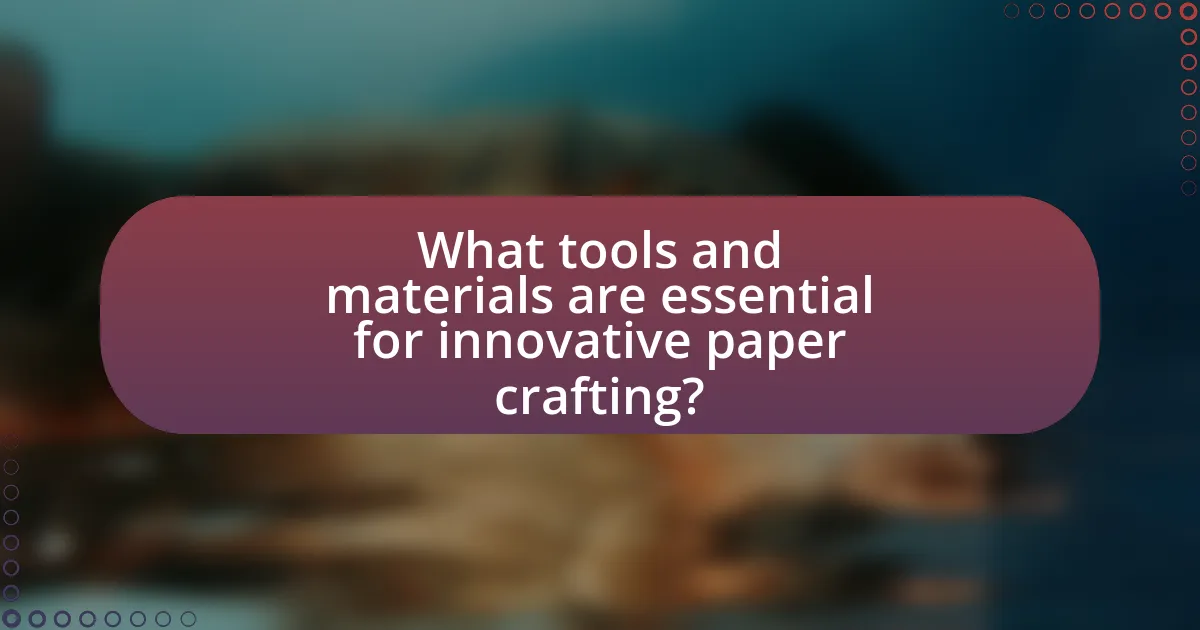
What tools and materials are essential for innovative paper crafting?
Essential tools and materials for innovative paper crafting include high-quality paper, cutting tools, adhesives, and embellishments. High-quality paper, such as cardstock or specialty papers, provides durability and allows for intricate designs. Cutting tools like precision knives, scissors, and paper trimmers enable accurate cuts and shapes. Adhesives, including glue sticks, double-sided tape, and liquid glue, are crucial for assembling projects securely. Additionally, embellishments such as stamps, stickers, and decorative elements enhance creativity and personalization in paper crafting. These components are foundational for executing advanced techniques beyond basic folding, allowing crafters to explore diverse styles and projects effectively.
How do different types of paper affect crafting techniques?
Different types of paper significantly influence crafting techniques by determining the material’s durability, texture, and suitability for various applications. For instance, heavier cardstock is ideal for structural projects like card making and scrapbooking due to its strength, while lighter papers, such as tissue or origami paper, are better suited for intricate folding techniques. Additionally, textured papers can enhance visual interest and tactile quality in crafts, affecting how adhesives and tools interact with the material. Research indicates that the weight and finish of paper can alter the effectiveness of techniques like stamping and embossing, as certain papers absorb ink differently, impacting the final appearance of the craft.
What are the best paper types for specific innovative techniques?
The best paper types for specific innovative techniques in paper crafting include cardstock for structural integrity, tissue paper for delicate layering, and watercolor paper for mixed media applications. Cardstock, with its thickness and durability, is ideal for techniques like pop-up designs and 3D structures, as it can withstand manipulation without tearing. Tissue paper, being lightweight and translucent, is perfect for techniques such as origami and paper flowers, allowing for intricate designs and soft textures. Watercolor paper, designed to absorb moisture, is suitable for techniques involving painting or wet media, enabling artists to create vibrant, blended effects without warping. These paper types are widely recognized in the crafting community for their specific applications, ensuring successful outcomes in innovative paper techniques.
How does the weight and texture of paper influence the crafting process?
The weight and texture of paper significantly influence the crafting process by determining the paper’s suitability for various techniques and the final aesthetic of the crafted item. Heavier paper, such as cardstock, provides durability and support for structures, making it ideal for three-dimensional projects like boxes or pop-up cards. Conversely, lighter paper allows for intricate folding and delicate designs, suitable for origami or layered embellishments.
Texture also plays a crucial role; smooth paper facilitates clean cuts and precise folds, while textured paper can add visual interest and tactile qualities to the finished piece. For example, embossed or patterned paper can enhance the overall design but may require adjustments in cutting and folding techniques to accommodate the surface irregularities. Thus, understanding the weight and texture of paper is essential for achieving desired results in crafting projects.
What tools are necessary for advanced paper crafting?
Advanced paper crafting requires tools such as a precision cutting knife, a self-healing cutting mat, a scoring board, and high-quality adhesive. These tools enable crafters to achieve intricate designs and precise folds, essential for advanced techniques. For instance, a precision cutting knife allows for detailed cuts that are crucial in creating complex shapes, while a scoring board ensures clean and accurate folds, enhancing the overall quality of the crafted piece. High-quality adhesive is vital for securing elements together without compromising the integrity of the paper.
How do cutting tools enhance precision in innovative techniques?
Cutting tools enhance precision in innovative techniques by providing clean, accurate cuts that allow for intricate designs and detailed work in paper crafting. These tools, such as precision knives, rotary cutters, and laser cutters, enable crafters to achieve exact measurements and angles, which are essential for complex projects. For instance, laser cutters can create precise shapes with tolerances as tight as 0.1 mm, significantly improving the quality of the final product. This level of accuracy is crucial in innovative techniques where alignment and detail are paramount, ensuring that each piece fits together seamlessly and maintains the intended aesthetic.
What role do adhesives play in innovative paper crafting projects?
Adhesives are essential in innovative paper crafting projects as they provide the necessary bond to hold various paper elements together securely. They enable crafters to create intricate designs, layered effects, and three-dimensional structures that enhance the overall aesthetic and functionality of the project. For instance, strong adhesives like PVA glue or double-sided tape allow for precise placement and durability, ensuring that crafted items maintain their shape and integrity over time. Additionally, the use of specialty adhesives, such as glue dots or spray adhesives, facilitates unique techniques like embellishing or attaching delicate materials, further expanding creative possibilities in paper crafting.
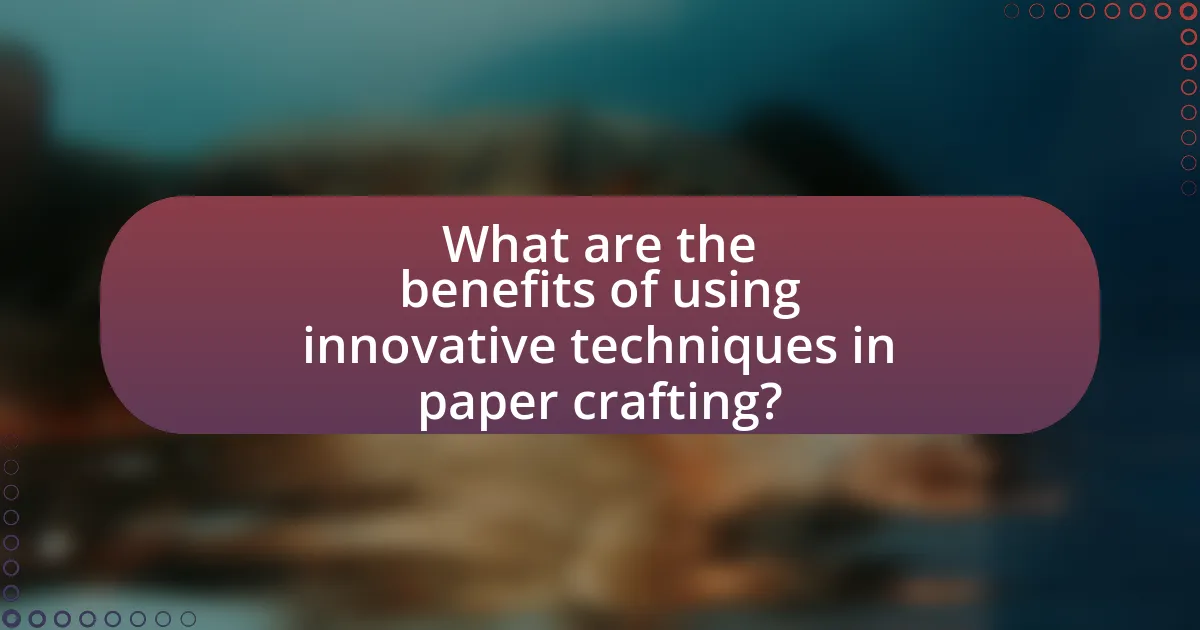
What are the benefits of using innovative techniques in paper crafting?
Innovative techniques in paper crafting enhance creativity, improve efficiency, and expand the range of possible designs. These techniques, such as laser cutting, digital printing, and 3D folding, allow crafters to achieve intricate details and complex structures that traditional methods cannot easily replicate. For instance, laser cutting can produce precise shapes and patterns, significantly reducing the time spent on manual cutting and increasing accuracy. Additionally, the use of digital tools enables crafters to experiment with various designs and materials, fostering innovation and personalization in their projects. This combination of enhanced capabilities and efficiency makes innovative techniques highly beneficial in the realm of paper crafting.
How do innovative techniques improve the quality of paper crafts?
Innovative techniques enhance the quality of paper crafts by introducing advanced methods such as laser cutting, digital printing, and 3D modeling. These techniques allow for precise cuts and intricate designs that traditional methods cannot achieve, resulting in cleaner edges and more detailed patterns. For instance, laser cutting technology can create complex shapes with high accuracy, reducing material waste and improving the overall aesthetic of the craft. Additionally, digital printing enables vibrant colors and detailed images to be applied directly onto paper, elevating the visual appeal of the final product. Research indicates that the integration of these technologies not only improves craftsmanship but also expands creative possibilities, allowing artisans to push the boundaries of traditional paper crafting.
What impact do these techniques have on the final product’s aesthetics?
Innovative techniques in paper crafting significantly enhance the final product’s aesthetics by introducing intricate designs, textures, and color variations. These techniques, such as layering, embossing, and die-cutting, allow crafters to create visually striking pieces that stand out. For instance, embossing adds depth and dimension, while layering can create a sense of complexity and richness in the design. Research indicates that the use of advanced techniques can elevate the perceived value of handmade items, making them more appealing to consumers. This aesthetic enhancement is crucial in distinguishing products in a competitive market, as visually appealing items are more likely to attract attention and drive sales.
How can innovative techniques increase the durability of paper crafts?
Innovative techniques can increase the durability of paper crafts by incorporating advanced materials and methods such as waterproof coatings, reinforced structures, and digital fabrication. For instance, using synthetic paper or applying a protective laminate can significantly enhance resistance to moisture and tearing, thereby extending the lifespan of the crafted items. Research indicates that the application of polymer coatings can improve the tensile strength of paper by up to 50%, making it more resilient to wear and environmental factors. Additionally, techniques like laser cutting allow for precise designs that minimize stress points, further contributing to the overall durability of paper crafts.
What are the emotional and psychological benefits of engaging in innovative paper crafting?
Engaging in innovative paper crafting provides significant emotional and psychological benefits, including stress relief, enhanced creativity, and improved focus. The act of creating with paper allows individuals to express themselves artistically, which can lead to increased feelings of satisfaction and accomplishment. Research indicates that engaging in creative activities, such as crafting, can reduce anxiety and depression levels, as it promotes mindfulness and a sense of flow. A study published in the Journal of Positive Psychology found that creative activities can enhance overall well-being and life satisfaction, supporting the notion that innovative paper crafting can serve as a therapeutic outlet.
How does crafting promote mindfulness and relaxation?
Crafting promotes mindfulness and relaxation by engaging individuals in focused, repetitive activities that require attention and creativity. This engagement helps to shift the mind away from stressors and fosters a state of flow, where individuals become fully immersed in the task at hand. Research indicates that activities like paper crafting can lower cortisol levels, the hormone associated with stress, thereby enhancing relaxation. A study published in the Journal of Positive Psychology found that participants who engaged in creative activities reported higher levels of positive emotions and lower levels of anxiety, demonstrating the mental health benefits of crafting.
What social benefits can arise from participating in paper crafting communities?
Participating in paper crafting communities can lead to enhanced social connections and a sense of belonging. These communities foster collaboration and sharing of ideas, which can result in friendships and support networks among members. Research indicates that engaging in creative activities, such as paper crafting, can improve mental well-being and reduce feelings of isolation, as individuals often bond over shared interests and projects. Additionally, participation in these communities can provide opportunities for skill development and mentorship, further enriching social interactions and community ties.
What tips can help beginners successfully adopt innovative techniques in paper crafting?
Beginners can successfully adopt innovative techniques in paper crafting by starting with simple projects that incorporate new methods, such as layering, embossing, or using mixed media. Engaging in tutorials, whether through online videos or workshops, provides practical guidance and visual examples that enhance understanding. Additionally, experimenting with various materials, like specialty papers or tools, encourages creativity and innovation. Research indicates that hands-on practice and exploration lead to improved skills and confidence in crafting, as noted in studies on skill acquisition in creative arts.
